I’m a sucker for the post apocalypse setting. To me, there’s just something I can’t quite shake in the themes the setting brings up: What do we do when everything has gone wrong? Will we band together as a society, or will we fall apart? How will regular people handle everything turning on its head? What can we do to make the world feel right again?
So when I saw Endzone: A World Apart in Early Access years ago, I knew I wanted in. A nuclear apocalypse? A Banished-style city builder where you rebuild society from the scraps around you? This seemed like it could be a slam dunk, and even if I didn’t like the game, I’d love the atmosphere.
What I didn’t expect was that Endzone would end up being one of the calmest takes on apocalypse I had ever seen.
The World Is Dead, Long Live The World!
Without mincing words, Endzone: A World Apart does exactly what it says it is going to do - this is a city builder, and one that is set at a time after some sort of accident triggered all the nuclear systems in the world to go off at once. If you have played Banished or any games of that city building style, you know what to expect: you start with a tiny population and a stack of supplies, and it's up to you to start getting all the resources you need through production and good city planning before shortages begin.
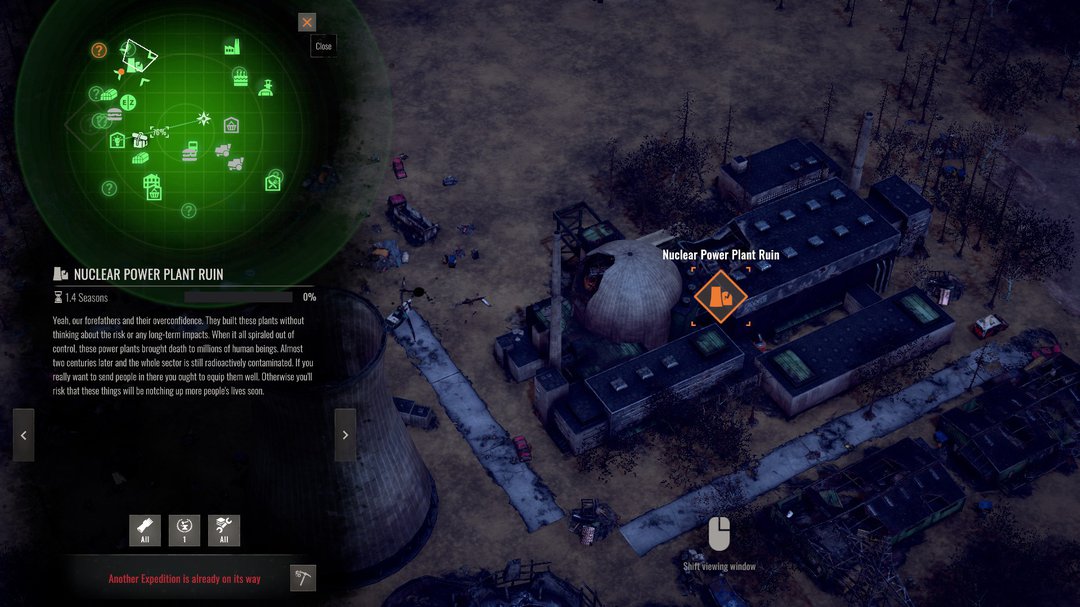
Nuclear power - the boogeyman of 101 apocalypses.
The twist to the game is the basic setting itself: rather than being in a forgotten part of the medieval hinterlands, you and your team of bunker-living survivors are some of the only people left. 100 years after the end of the world, it's up to you to start rebuilding. Radiation levels and drought replace the more standard natural disasters of other city builders. Your citizens don’t mine for metal so much as take apart the ruins of the past.
It’s a fun little twist to what’s become a tired trope in this style of city building. It isn’t quite sci-fi, and it isn’t set in ye olde medieval times either. It allows for the developers to build on their theme in some fun ways that help make this game stand out in a crowded field.
Enjoying A Ruined World
Like many games in this style, your citizens operate by how you assign jobs to the whole of the community. At first, this is very standard fare: you need people to collect logs, collect scrap metal, find food… things get a little more interesting as the apocalyptic setting kick in. Water is your most basic resource, and while it is usually easy to get, it can be threatened when droughts entirely drain the lakes you build around.
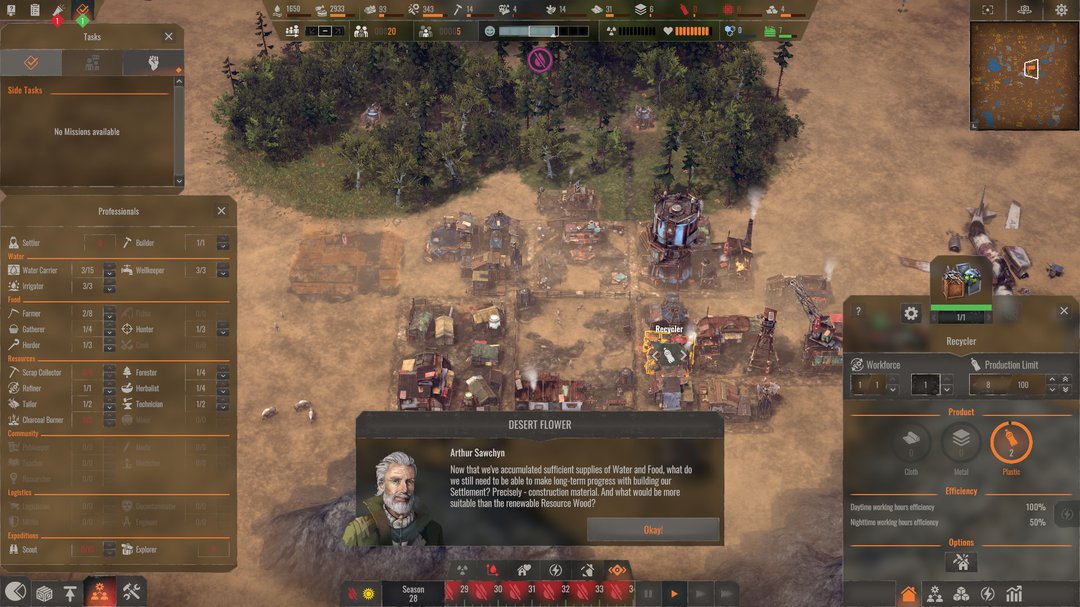
Here, you can see how drought has made the terrain look awful. Food can't grow, including berries and herbs. While I don't have crops yet in this run, keeping that little bit of forest alive with irrigation is my lifeline.
Suddenly, you realize there’s a reason why you had to build storage towers. In addition, the droughts get so bad the land can dry out for seasons at a time, making your farms and orchards no longer make food. So, you learn to make wells so you have constant access to a lifeline of water. You start planning ahead by building irrigation centers to keep small patches of earth damp enough to keep sustaining life.
On top of all this, radiation can a sneaky (perhaps too sneaky) threat as well. Collecting rainwater is a great way to keep supplies high, but radioactive downpours can end up poisoning the supply. You aren’t building clothes for your citizens so much as gasmasks and hazard suits as you prepare for bad weather. The amount of times I was absolutely thriving for 30+ seasons and then suddenly had dozens of people dying was because I had hoped having just cloth handkerchiefs would be a way to save time and energy. I was wrong.
These are some of the initial ways that Endzone grounds itself in the setting, but there are plenty of others. Raiders from outside your community can threaten the town, and once you get a town forum built, you can play at using edicts to boost morale or take desperate actions to save your town - such as, perhaps, banishing your elderly into the radioactive wilderness. Yikes. Trust me, you won’t have to worry about surprise slaughter from zombies, but if you aren’t careful about managing your supplies and preparing about how the setting could threaten that productivity, you can find your city in a downward spiral. Not enough water means not enough food, which means more people sick, which means more people dying, which means less people building tools, which- you get the idea.
The Aesthetics of Apocalypse
It’s not all doom and gloom however, and part of that is how well the game manages to take a genre that can often feel very generic and infuse a little life into it. I adore the hodgepodge nature of your town as it begins to grow; tarps and ramshackle metal sheets can be seen on top of houses and workshops. It feels lived in and cozy while keeping that touch of desperation you need to be feeling when in this sort of setting.
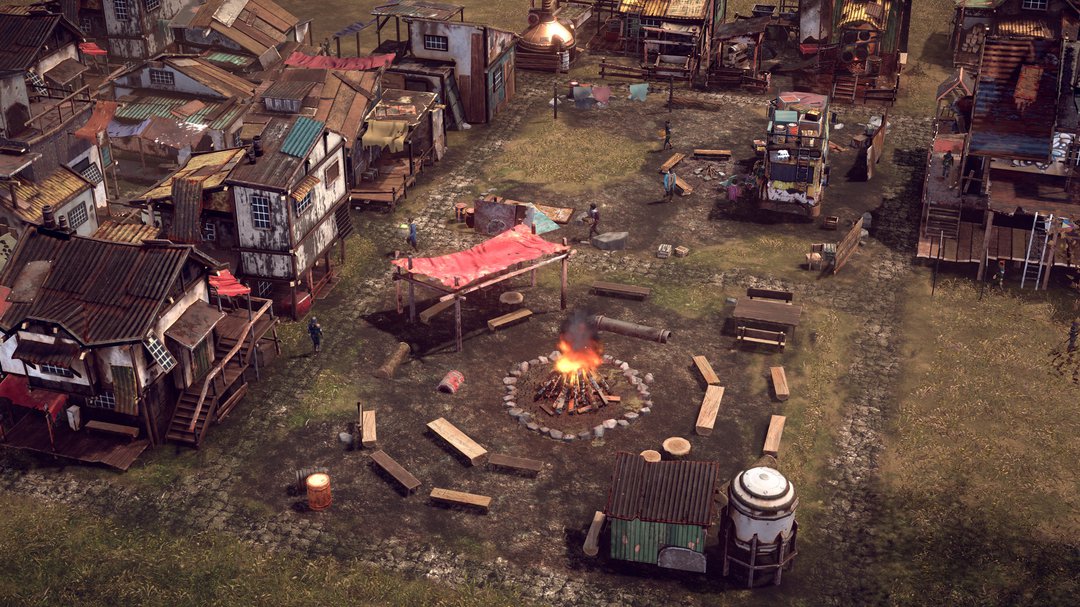
One of the first locations you can build as a place for people to gather and raise morale brings back good memories of camping and sharing stories. It shows how your town feels ramshackle and run down but also somehow inspiring and hopeful.
The wooden barely-held-together sprawl can start to blend together however after looking at it long enough, but Gentlymad studios has added a lot to the game since its full release to help with this. First, your larger buildings stand out nicely, especially when you begin to upgrade them. The developers have also added a lot of aesthetic decorations to the game, ranging from flower beds to planted flags to full on unlockable landmark locations such as pavilions or memorial statues. There’s a free halloween DLC they added which adds fun bits like Cthulhu statues, so you can theme your survivor city as a weird cult… you have options.
What’s best about this though is how it ties back into the gameplay. Aesthetic upgrades add happiness to homes nearby, giving you incentive to build residential quarters while stuffing all your industry somewhere else. When you start a game of Endzone, city planning is quick and rushed to get the essentials, but encourages you to go back and master your growing city later on. When you unlock electricity, you'll want to bulldoze your original sprawl to make it easier to live for everyone. As you get access to medical aid, you'll learn to build blocks around nessecities for the ease of your citizens, and you are rewarded for constantly making your township look better, for making it feel more like a city. This is all amplified by the Prosperity expansion to the game, but we’ll get to that later.
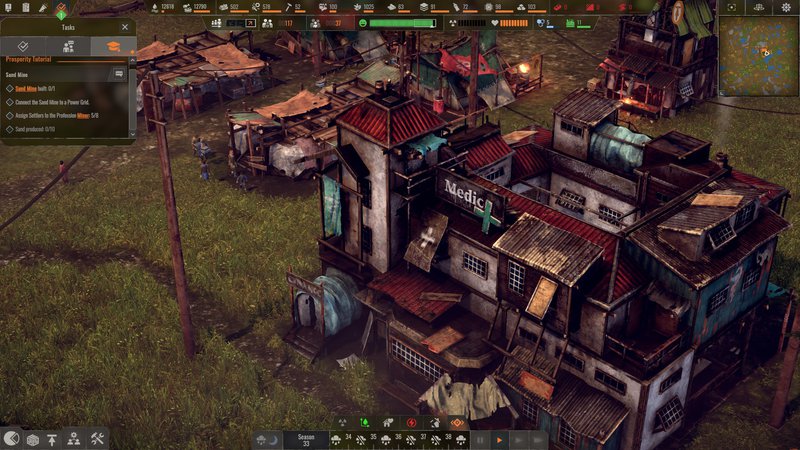
Finally, I just want to touch on the sound design. Little sound effects like creaking wood or water dropping into a pool greet you as you click over various buildings again add to the feeling that this isn’t a normal city, but still give you a little cozy thrill. However, the real surprise winner for me is the music. You’ll hear the main theme a lot in this game, and it's a mix of chill ambient synthesizer interrupted by occasional metallic pings and echoes. It’s haunting, beautiful, and relaxing all at once. For me, it encapsulates Endzone when it’s firing on all cylinders really well.
A Broken World, An Unexplored World
The game loop of Endzone is pretty straight forward: keep improving the city so you can then make the city larger. Once you successfully start giving birth to the next generation of civilians, you need to make sure they have enough food and supplies so that they can start to improve the quality of that food and supplies, so that you are ready for the next set of civilians… rinse and repeat.
This loop is complicated in a very Frostpunk sort of way; as the seasons wear on, the droughts you experience will grow longer. Radiation will blanket your town more regularly, and events such as dust storms will damage your buildings with increasing frequency. These problems can be speedbumps to your progress at best or absolutely throw you off course if you aren’t prepared for them. Did you accidentally let your city grow too fast without building a hospital? Well, that recent disease seems to be shutting down all of your food production for a few seasons, so good luck with that.
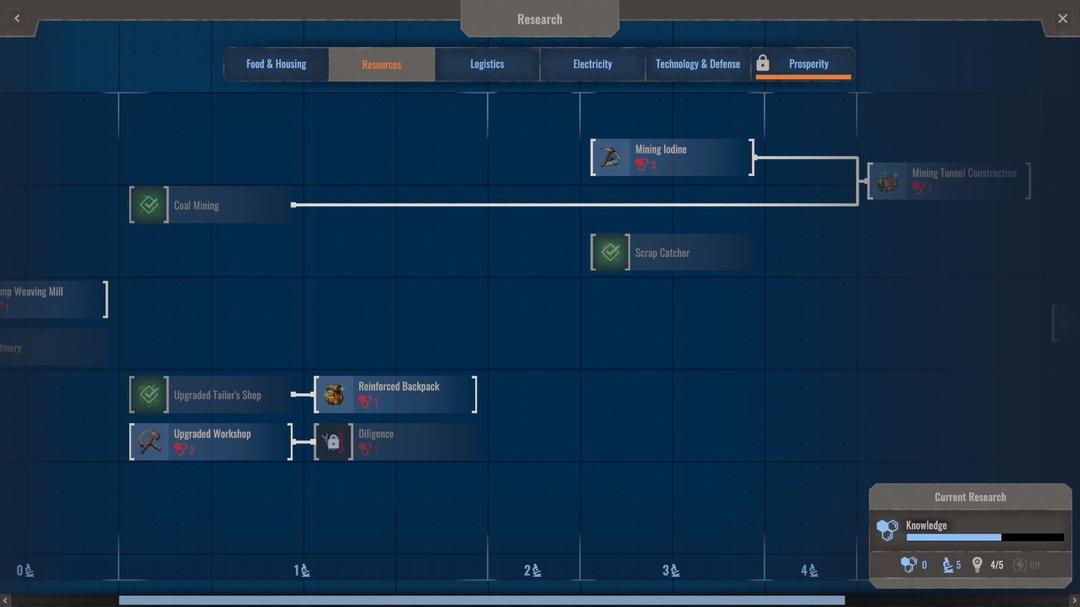
There is a tech tree in Endzone, but it requires exploration of old world ruins to truly advance your starting civilization.
However, the real winner in Endzone is the exploration station. Maybe it's because of my ADHD, but the gameplay loop of a basic city builder can’t keep me fully engaged on its own without being spiced up by a dramatic story arc (see Frostpunk) or through special events. In Endzone, a map becomes more interesting by the old world ruins you find on it, such as warehouses or military bases or even destroyed power plants.
By building an expedition station, you can head out to these locations and find resources for your home. These missions are small events that are made interesting by the stories attached to them: characters finding a bedroom full of conspiracy theory books or last messages to their family gives more flavor to the world. You can get rewards like new seed types to plant or scientific supplies for your tech tree, but you are incentivized to bring along specialists for different tasks, making you want to prioritize having schools and having civilians who are really good at their jobs. It’s a fun system that gives a little flair to the standard gameplay.
Endzone isn’t a game that’s hugely concerned with a cohesive story, but it makes sure to take time to let you as a player slip into the setting. When your city suddenly takes a turn for the worse due to radiation, it makes sense. You cheer when you get a rare trader to stop by with supplies, you feel relief when you finally get electricity running through your city. The first real successful city you manage to create is very satisfying.
A Maybe Too Cozy Citybuilder
Now I don’t want to compare this game to others too closely, but on a scale from peaceful SimCity to Frostpunk’s constantly tense timeline, Endzone tries to have its cake and eat it too. It walks a really strange tightrope between its setting and its gameplay; it’s a balancing act I appreciate, but I don’t think it always gets right.
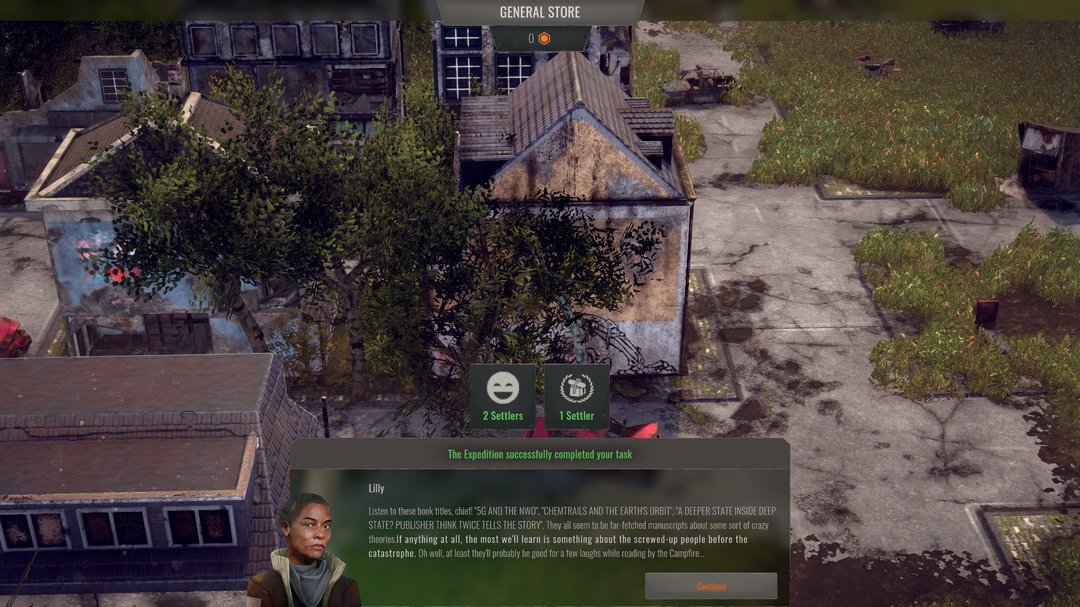
Exploration gives you access to little snippets of personality and theming I wish the game went a little deeper with overall.
On one hand, you do have slowly escalating droughts, but on the other you have incredibly chill music. You have to balance morale and the quality of your supplies to keep everyone working hard, but sometimes you’ll have multiple people die off and there are barely any alerts that you are beginning to lose the game. In one early play through, I didn’t realize that my mortician died off first in a disease event. I was so busy trying to replace farmers and water collectors that I couldn’t figure out why my morale was constantly collapsing, and the game didn’t alert me as to the exact reason why.
Both the tone and the difficulty in Endzone seem to jump back and forth in this way, and it can be jarring. I will admit to playing the game for hours on end, savoring the slow pace on a rainy afternoon where I was sleep deprived due to a toddler, then suddenly realizing my city was out of a valuable resource and I wasn’t even sure when the problem started. Everything was fine, until suddenly the collapse was all too quick and weirdly without fanfare. I had sunk into the lazy river style enjoyment before suddenly finding myself going over a waterfall.
 Endzone: A World Apart
Endzone: A World Apart
Developer: Gentlymad Studios
Publisher: Assemble Entertainment
Platforms: PC
Number of Players: 1
Price: $30
Release Date: March 18, 2021
There are a few other sticking points I have to be critical of. Like many city builders in this particular style, some players might find themselves getting frustrated in how opaque problems can be. You set the goals to make the right tools, and because of sickness or a lack of supplies, they aren’t made for days. Occasionally, I watched the toolmaker’s name hover over his house, not returning to work for more than just a weekend as productivity across the city fell apart. Sometimes, you set a building to be a priority build, and I’d watch other buildings be completed first anyway.
Finally, while I am very happy that Endzone has multiple scenarios which helps with replayability, a lot of these scenarios end up being very similar. A goal of “Survive 100 seasons” is a fun benchmark to hit, but the next scenario you play could be something such as “have 200 citizens”... which is a benchmark you would hit in the natural course of playing a long game of many seasons. Again, this goes back to the same issue: Endzone is a really solid game, but sometimes it's lacking that extra bit of dazzle to make it truly shine.
Expansions For Fun And Prosperity
Fortunately, it seems that GentlyMad Studios realized that its city builder ran into the same issues as many other in the genre - the mid to end game feeling a bit stale - and decided to do something about it. Since launch, two DLCs were made to add more content and variety. For the most part they succeed, and they do well to round out the game’s overall scope and theme.
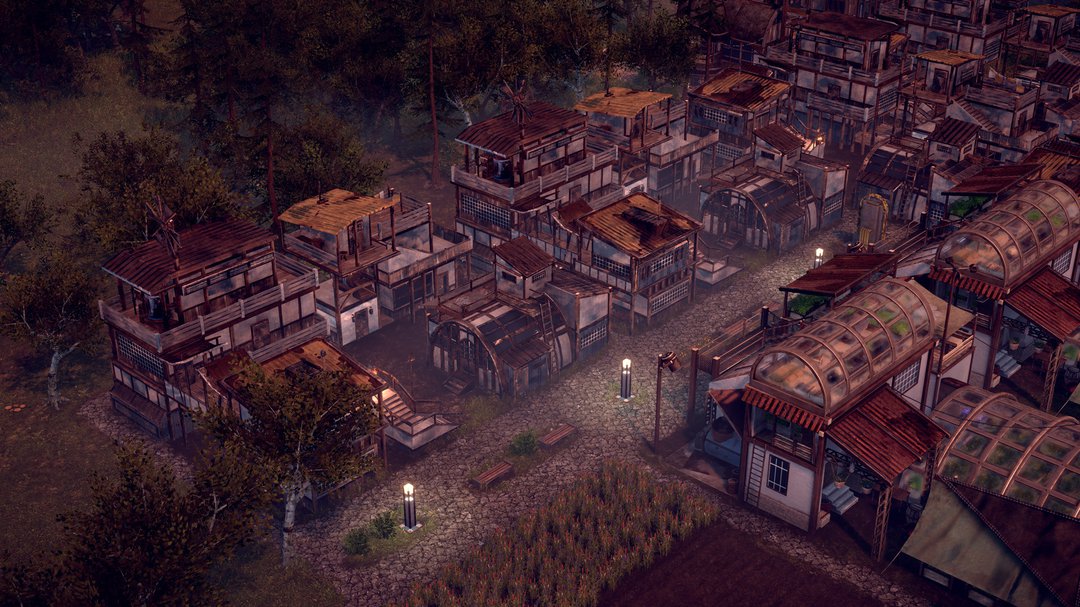
If you like the idea of the base game, Prosperity is a mustbuy expansion. It lets you watch your city grow taller and more refined, giving a real sense of progression. If you make it to indoor greenhouses and concrete buildings, it feels well earned.
The first one, Prosperity, is truly successful. If you like endless modes in city builders, you will really enjoy how this expansion essentially adds a new era to gameplay. To summarize: if your town survives long enough to start feeling stable, you can choose to upgrade your town center into a City Hall. This triggers a massive change in how your town works and also unlocks a lot of new potential.
In the base game, you can create improvements that make your town feel a little less shantytown such as having bars or generating electricity, but Prosperity suddenly unlocks entirely new resources. No longer are you ever desperate to find more ruins to tear down for scrap, but now you produce concrete and can make luxuries such as cake. Cities begin to look like, well, actual cities instead of piles of scrap metal. The quests you can take from the town center now become demands from the populace of a stable city, something that might force you to change your expansion plans because someone wants a particular luxury.
The second DLC, Distant Places, is fun but hard to recommend as strongly. It takes the expeditions of the base game and supercharges them, allowing you to build a balloon for long distant trips to destinations that are a welcome change of pace, such as an old broken down train or a marooned ocean liner.
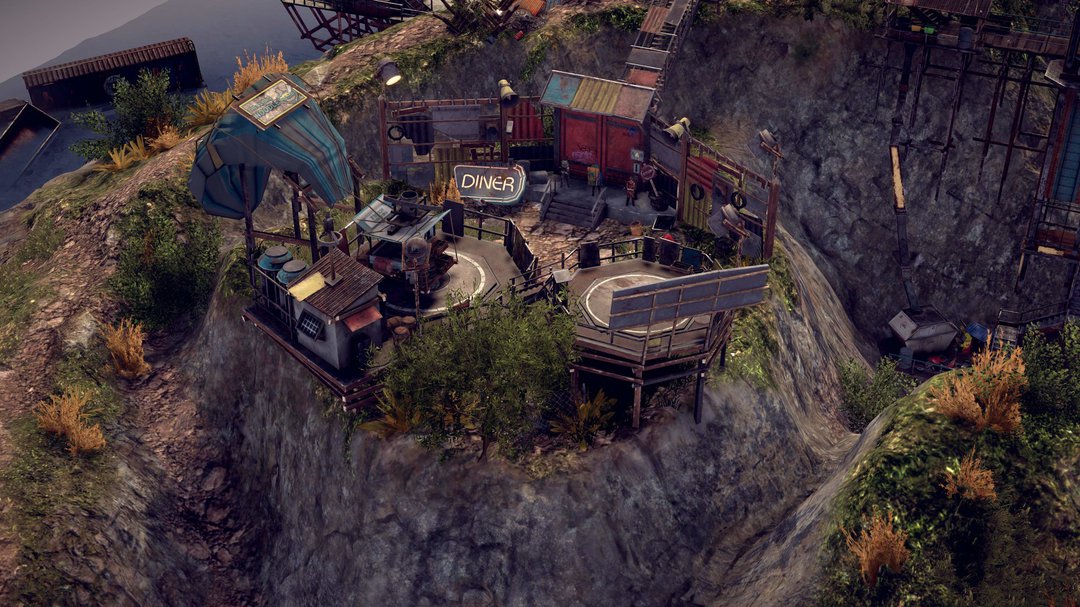
The catch is that well, you can’t really build there - these are expeditions, and there are a dozen story-driven events that can happen in these locations. Completing them gives you more options for your home, new styles of seed such as bananas, allowing you to create a healthier community… but that’s about it. To be fair, I love that this DLC adds on a touch more story and broadens the scope of the world, it’s just that I wanted more. It's a great start of ideas, but I would have gladly payed more for this expansion if it came with bolder content to add to the base game and more story themed situations than these exploration capstones.
If anything, I really enjoy the expansions because it takes a base game that needs a few more unique mechanics to spruce up the theme, and they deliver.
A Heartwarming Way To Survive The Apocalypse
I know I’ve come across as harsh in some sections of this review, and I think it’s because I find myself really wanting to make this game one I can recommend wholeheartedly, and at the end of the day, I simply can’t. I really do adore this game: its music, concept, and atmosphere of quiet hopefulness even in the face of catastrophe have made it one I can’t quite shelve. Endzone has so many good ideas and pulls back just before reaching greatness.
I currently have logged over 120 hours in Endzone: A World Apart. I think it’s a great game to play when you want a challenge, but you don’t have to rush. I think it’s a brilliant start of an idea that needs to be either better polished or try and push its ideas a little further. This might be because I played it so much during those first few months of parenthood, but I think this is a great dad game. I just wanted that little bit more to make it stand out.
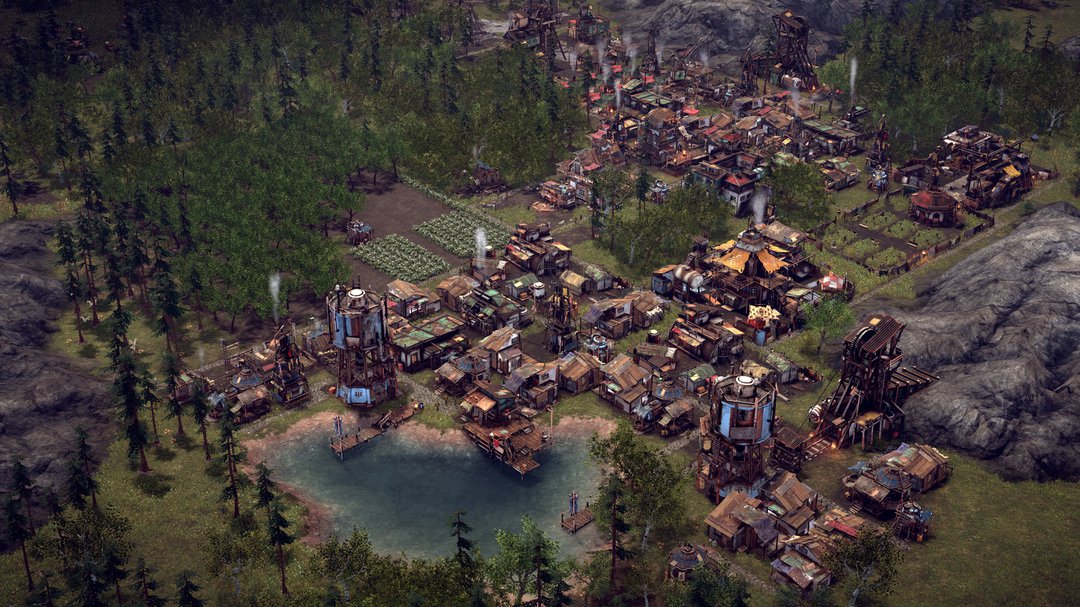
Endzone retails for around $30, and with both expansions it goes up to $50. I absolutely recommend putting this game on your wishlist and buying it as a bundle when a good steam sales comes along. Even if it isn’t your cup of tea, I think it’s a solid game and a great mood, one worth experiencing if just for a little while.
Editor’s note - as of this article’s publication, Endzone is currently on sale for less than $5, and you can get the whole package for under $15! If you see the game for a price like this, I think it’s a great buy for a weekend or two of play.
As for me? I know Endzone 2 went into early access recently, and I liked how the demo I played a year ago tried to expand on ideas in new and interesting ways. I wanted to wait a while longer before buying in, but editing this article has made me wistful, and I want to see what Gentlymad Studios tries next. Maybe it’s time for one more run of the original, one last relaxing night trying to rebuild after the apocalypse before it's off to the next adventure.